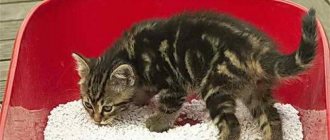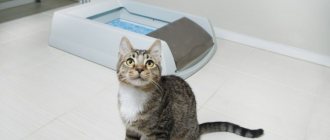One of the reasons that encourages owners to castrate their beloved cat is constant territory marking.
But it often happens that the animal retains the habit even after surgery, which unpleasantly surprises the owners. Unfortunately, it is impossible to predict whether a neutered cat will mark territory or not, since such a habit is determined by basic instincts. Even if the animal continues to leave such “surprises”, it can be weaned from marking. The main thing is to understand the reasons for this behavior.
Nature of the phenomenon
Many owners mistakenly confuse leaving marks with simple urination. If an animal excretes urine on vertical surfaces and standing objects, then we are talking about sexual manifestation. If a cat urinates on a horizontal surface but walks past the tray, this indicates a malfunction or revenge of the animal.
Marking territory is a natural instinct present in every sexually mature male. By leaving its mark on various objects, the animal warns others about its right to territory and attracts females.
Natural instinct - attracting females
In addition to the territory and apartment, cats often begin to mark the owner’s things, most often clothes and shoes. This is due to the fact that these wardrobe items retain the smell of the street and foreign territory, so the animal tries to kill it with its pheromones.
It is worth considering that not only cats, but also cats have the habit of marking territory. It usually appears during a period of hormonal activity to attract males. Also, animals often begin to actively leave their marks everywhere if several pets live in an apartment at once.
Do neutered cats mark?
There is no point in doubting whether a neutered cat can mark territory. Another thing is whether the animal will retain its original habits after the operation. As practice shows, about 30% of castrated cats continue to leave marks, so the previous problems persist.
This phenomenon is caused by natural instincts, and not by bad character or the desire for revenge. It is much easier to wean a neutered pet from leaving strong-smelling marks than an unsterilized one. But first you need to figure out what motivates the cat to such actions.
Attention! The optimal period for castration is from 8 months to a year.
What to do if the cat continues to walk?
Most likely, just be patient. Gradually the cat will calm down, nothing bad will happen to it. But what you definitely can’t do is give your pet hormonal sedatives, like Sex Barrier and similar drugs. The problem is that their long-term use during the action of animal hormones remaining in the blood is a sure path to the development of cancer.
To make your cat calmer, you can take the following actions:
- It is necessary to consult a veterinarian. There are many natural herbal sedatives on the market today. A specialist, guided by the information obtained after examining the animal, will help you choose the most effective one. Such medications are safe and their use does not pose any consequences in the future.
- We recommend gradually reducing your caloric intake. The less excess energy there is in the animal’s body, the calmer it will be. In addition, with a balanced diet, the risk of gradual obesity of the sterilized animal goes away.
- During agitation, it is advisable to isolate the cat in a separate room. Minimizing stress is a good way to calm your pet without resorting to other methods (including medications).
We suggest you read: Distemper in cats - symptoms, treatment and prevention
Reasons why castration did not help
There is no guarantee that the animal will stop marking its territory after castration. This is due to the fact that even after the operation, natural habits and instinct will not go away.
The operation does not guarantee that the cat will stop marking.
The main reasons why a neutered cat marks after surgery:
- Preservation of physiological and psychological characteristics. If the operation was performed in adulthood, for example at 5 or 6 years old, the likelihood of maintaining the habit increases several times, since by this time it will be well ingrained. In this case, the owners can only rely on the fact that the animal will stop leaving marks as the production of sex hormones decreases.
- Incorrectly performed operation. With cryptorchidism, the testicle may not exit into the scrotum; in this case, during castration it is not removed and the body continues to produce hormones. The original behavior and habits of the animal are preserved, since the cat will feel the need to mark the territory.
- The presence of diseases of the urinary system , for example, cystitis or urolithiasis. The owner needs to observe the behavior of the pet and, if questionable symptoms appear, show it to the doctor.
- Presence of other animals in the apartment. Often males continue to leave scent marks if they hear the smells of other cats living in neighboring apartments. If there are other pets nearby, correcting the situation will be problematic, since the animal will continue to defend the territory and show who is boss.
- Negative impact of a stressful situation. Cats and cats do not tolerate stress well. As a rule, emotional experiences affect their health and habits. Moving to a new house, the appearance of a child or another animal in the apartment, quarrels between family members - all this can cause the animal to continue to leave marks after castration.
It often happens that a cat marks its territory due to rough and harsh treatment by its owner. Veterinarians warn that the behavior of pets largely depends on how the owners themselves behave.
Attention! After castration, the cat will not immediately stop leaving marks, as it takes time to adapt. In addition, this habit goes away as hormone production stops.
General information about castration
Castration is a surgical operation to remove the testicles (testes) of a cat. This is the only procedure that guarantees control over a cat’s sexual desire and related problems.
The operation is performed under general anesthesia, which requires certain preparation.
- Even if the cat looks absolutely healthy, 2 weeks before castration you need to carry out parasite prevention and show your pet to a veterinarian.
- Before castration, the cat must receive a full course of vaccination or revaccination.
- The veterinarian examines the cat for breathing and heart problems. If the doctor has any doubts, he will recommend contacting a veterinary cardiologist.
The cat's blood must be taken for analysis. Contraindications for the use of anesthesia are:
- Reduced hemoglobin - indicates anemia, which can cause severe complications when recovering from anesthesia and rehabilitation after surgery.
- Rapid erythrocyte sedimentation indicates oxygen starvation of cells and low immune defense of the body. Red blood cells carry blood throughout the body, and their rapid sedimentation indicates rapid death.
- An increased number of leukocytes may indicate an infection or virus that is already attacking the cat’s body. Anesthesia will significantly reduce the body's immune defense, which will allow any illness to develop into an acute form.
To tolerate anesthesia normally, the cat must be healthy and have an adequate weight for its build. The veterinarian will prescribe a diet for your cat if he is obese or malnourished. In the second case, if the weight loss is not caused by a serious illness, the situation is a little simpler. The cat needs to be kept on a diet rich in carbohydrates, and after the operation, transferred to a special food for emaciated animals. In the case of obesity, weight loss should occur gradually. Too sharp burning of fat tissue literally poisons the body with decay products.
What to do?
Many cat owners hope that after castration the problem of leaving marks will be solved by itself. But it often happens that even some time after the operation, the pet’s habit persists. In this case, you need to know what to do correctly and wean your pet from marking, since the released pheromone has a specific and pungent odor, which is extremely difficult to get rid of.
It is necessary to find out the reason
To increase the likelihood of a favorable outcome, the owner must try to find out why the animal continues to leave marks. If possible, you can consult a veterinarian or animal psychologist.
It is strictly forbidden to show aggression and anger towards a pet, since the animal in any case will not understand why it will be punished. It should be borne in mind that physical punishment can only aggravate the situation, since the animal may begin to take revenge.
How to deal with your pet’s habit of leaving marks depends on what is its primary source:
- If marking the territory is associated with the presence of other pets in the apartment, the owner needs to be patient and wait time. In a few weeks, the pain after surgery will go away, the cat will get used to the new “neighbors”, feel self-confident and stop leaving marks. To facilitate the rehabilitation period, the owner needs to pay as much attention as possible to the pet, constantly play and communicate with it.
- If the marks are a consequence of a disease or a poorly performed operation, only a professional can help correct the situation. After a physiological examination, the veterinarian will prescribe appropriate treatment or further surgery.
- Cat marks can be a reaction to a dirty litter box. Owners should wash their pet's potty daily to minimize the likelihood of this problem occurring.
As practice shows, the habit of marking territory is usually eradicated 4-6 months after castration. If after this period the animal continues to leave marks, it is recommended that the pet be checked at the clinic for the presence of hormonal abnormalities.
We need to be patient
To eradicate this habit, you can use the following psychological techniques:
- When a cat puts a mark, you can catch him and lift him by the withers, sternly scolding him out loud. This technique will make your pet feel vulnerable, and he will not want to do the same actions again. To enhance the effect of “punishment”, you can hiss at your pet; he will take this sign for aggression.
- The owner needs to show that he is the boss in the house and show the animal that it is forbidden to mark the territory. When the pet begins to do its “business”, you need to lightly flick it on the nose with your finger.
- An alternative option is to use strong scents to repel cats. Cats do not like the smell of citrus fruits, so the place where the animal is accustomed to leaving marks can be sprinkled with lemon or orange juice. You can also put a little peeled zest in this place.
The disappointment of owners when the cat continues to leave marks is understandable and obvious. The first thing you want to do at such moments is to yell at your pet and poke his face into the smelly puddle. But doing this is strictly prohibited. Such actions not only make no sense, but can also aggravate the situation, provoking aggression and revenge from the animal.










